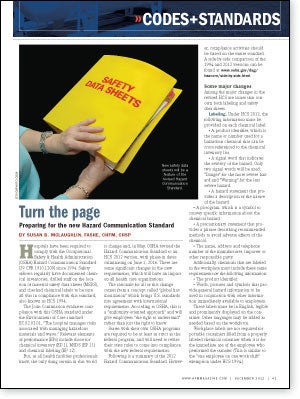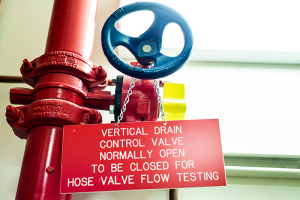Turn the page
 Hospitals have been required to comply with the Occupational Safety & Health Administration (OSHA) Hazard Communication Standard (29 CFR 1910.1200) since 1994. Safety officers regularly have documented chemical inventories, drilled staff on the location of material safety data sheets (MSDS), and checked chemical labels to be sure all was in compliance with this standard, also known as HCS 1994.
Hospitals have been required to comply with the Occupational Safety & Health Administration (OSHA) Hazard Communication Standard (29 CFR 1910.1200) since 1994. Safety officers regularly have documented chemical inventories, drilled staff on the location of material safety data sheets (MSDS), and checked chemical labels to be sure all was in compliance with this standard, also known as HCS 1994.
The Joint Commission evaluates compliance with this OSHA standard under the Environment of Care standard EC.02.02.01, "The hospital manages risks associated with managing hazardous materials and waste." Relevant elements of performance (EPs) include those for chemical inventory (EP 1), MSDS (EP 11) and chemical labeling (EP 12).
But, as all health facilities professionals know, the only thing certain in this world is change and, in May, OSHA revised the Hazard Communication Standard to an HCS 2012 version, with phase-in dates culminating on June 1, 2016. There are some significant changes in the new requirements, which will have an impact on all health care organizations.
The rationale for all of this change comes from a concept called "global harmonization" which brings U.S. standards into agreement with international requirements. According to OSHA, this is a "uniformity-oriented approach" and will give employees "the right to understand" rather than just the right to know.
States with their own OSHA programs are required to be at least as strict as the federal program, and will need to revise their state rules to come into compliance with the new federal requirements.
Following is a summary of the 2012 Hazard Communication Standard. However, compliance activities should be based on the entire standard. A side-by-side comparison of the 1994 and 2012 versions can be found at www.osha.gov/dsg/hazcom/sidebyside.html.
Some major changes
Among the major changes in the revised HCS are issues that concern both labeling and safety data sheets.
Labeling. Under HCS 2012, the following information must be provided on each chemical label:
- A product identifier, which is the name or number used for a hazardous chemical that can be cross-referenced to the chemical inventory list.
- A signal word that indicates the severity of the hazard. Only two signal words will be used: "Danger" for the more severe hazard and "Warning" for the less severe hazard.
- A hazard statement that provides a description of the nature of the hazard.
- A pictogram, which is a symbol to convey specific information about the chemical hazard.
- A precautionary statement that provides a phrase describing recommended methods to avoid adverse effects of the chemical.
- The name, address and telephone number of the manufacturer, importer or other responsible party.
Additionally, chemicals that are labeled in the workplace must include these same requirements or the following information: - The product identifier.
- Words, pictures and symbols that provide general hazard information to be used in conjunction with other information immediately available to employees.
These labels must be in English, legible and prominently displayed on the container. Other languages may be added as needed based on the workforce.
Workplace labels are not required for portable containers filled from a properly labeled chemical container when it is for the immediate use of the employee who performed the transfer. (This is similar to the "one employee on one work shift" exemption under HCS 1994.)
Safety data sheets. Under HCS 1994, material safety data sheets prepared by chemical manufacturers were required to contain specific information, but were not required to be in any particular format. Thus, they were sometimes difficult to read and follow.
All of that changes with the 2012 version and the introduction of safety data sheets (SDS). These are based on the American National Standards Institute's Z400.1 and Z129.1-2010, Hazardous Workplace Chemicals — Hazard Evaluation and Safety Data Sheet and Precautionary Labeling Preparation. A common format and section headings are mandated. SDS must contain the following information:
- Section 1: Identification. This includes a product identifier, manufacturer information and recommended use.
- Section 2: Hazard(s) Identification. This includes the hazard classification, signal word, hazard statement, pictogram and similar information.
- Section 3: Composition/Information on Ingredients.
- Section 4: First Aid Measures.
- Section 5: Fire Fighting Measures.
- Section 6: Accidental Release Measures. This includes personal precautions, emergency procedures, containment and cleanup.
- Section 7: Handling and Storage.
- Section 8: Exposure Controls/Personal Protection. This includes exposure limits, engineering controls and personal protective equipment.
- Section 9: Physical and Chemical Properties.
- Section 10: Stability and Reactivity.
- Section 11: Toxicological Information. This includes information on health effects.
- Section 12: Ecological Information.
- Section 13: Disposal Considerations. This includes containers and methods.
- Section 14: Transport Information.
- Section 15: Regulatory Information.
- Section 16: Other information, including date of preparation or last revision of the SDS.
All headings must be listed as stated and in the same order. If there is no applicable information for a particular chemical under one or more of those headings, that must be indicated under the section heading.
Note that Sections 12-15 will be enforced by agencies other than OSHA, as these topics are not under OSHA
jurisdiction.
SDS must be provided in English, but the information may be provided in other languages as appropriate to the employee population. As before, electronic alternatives to paper SDS are acceptable, but there must be immediate access to the employee in each workplace. A backup must be available for access during a power failure or emergency, but this does not necessarily mandate hard copies. A CD to be used in a laptop computer on battery power would be one compliance example.
Minor differences
In addition to these major changes, there are a number of minor differences in the new HCS.
Hazard classification. For all chemicals, manufacturers or importers are responsible for determining the hazard classification and category of the respective chemical. There is no requirement for testing of the chemical, but scientific literature and other available information must be taken into consideration.
In HCS 1994, manufacturers and importers were required to evaluate chemicals to determine if they were hazardous, but employers also had the option not to rely on this information and make their own determination. Although OSHA considers this a significant change, most health care organizations have deferred to the manufacturer determination all along.
Terminology. Some terminology changes have been made to align with the globally harmonized system. Most users will not have difficulty with these changes, as they are relatively self-explanatory. For example, "evaluate," "assess" and "determine if they are hazardous" in the 1994 version all have been replaced with the word "classify."
Some terminology is completely new, including "pictogram" and "signal word." There is a complete definition section within the standard to help with any questions that may arise.
Some consistencies
Finally, the new edition of the HCS has some consistencies with the 1994 version of the document.
Hazard communication plan. Under the 2012 HCS, there is still a requirement for a written hazard communication program, including a chemical inventory listing. The elements to be contained therein remain the same, save for a few terminology changes related to the new system, such as "product identifier" and "Safety Data Sheet." Current programs will require some editing, but should not involve major rewrites.
Training. The only changes to the employee training requirements from 1994 to 2012 are based on terminology changes and, obviously, the new labeling and SDS requirements. Contents of the training program must include:
- Operations in the workplace where chemicals are used.
- Location and availability of the hazard communication program.
- Methods to detect the presence or release of a hazardous chemical.
- Chemical hazards.
- Means of personal protection.
- Details of the hazard communication program.
Developing a plan
Although the Dec. 1, 2013, deadline for training employees on the new labeling system and SDS format is about a year away, and another 2.5 years are permitted for full compliance, it's not too early to begin planning and implementing the transition to HCS 2012. Facilities professionals can start by reviewing the information on the OSHA website at www.osha.gov/dsg/hazcom/index.html.
One key to planning and developing an employee training system to meet the Dec. 1, 2013, deadline is modifying existing programs for new employee orientations and annual updates where this information is addressed.
If a facility is using a vendor for an electronic MSDS, the vendor should be contacted to determine its process for conversion to SDS by June 1, 2016. If hard copy MSDS are in use, one process should be developed to replace them with the new format as the SDS arrive with chemical shipments, and another process should be developed to request from the manufacturer those SDS that have not been received. Alternatively, this may be the time to move to an HCS 2012-compliant electronic system.
Chemicals shipped to health care facilities are required to have the HCS 2012 labels by Dec. 1, 2015. It is likely, though, that an organization still will have some chemicals that are labeled under the old system. A process should be developed to relabel such on-site chemicals with appropriate labels prior to the June 1, 2016, deadline. Chemical vendors can be consulted for suggestions and assistance.
Finally, the health care organization's hazard communication program must be updated to include the modifications for HCS 2012.
Susan B. McLaughlin, FASHE, CHFM, CHSP, is managing director of MSL Healthcare Consulting Inc., Barrington, Ill., and a former associate director of standards interpretation at the Joint Commission. She can be reached at smclaughlin@mslhealthcare.com.
| Sidebar - Important dates |
| As the 2012 Hazard Communication Standard is phased in, the following two dates are crucial to health care organizations:
In the interim, compliance must be maintained with either the 1994 or the 2012 version of the standard. |




